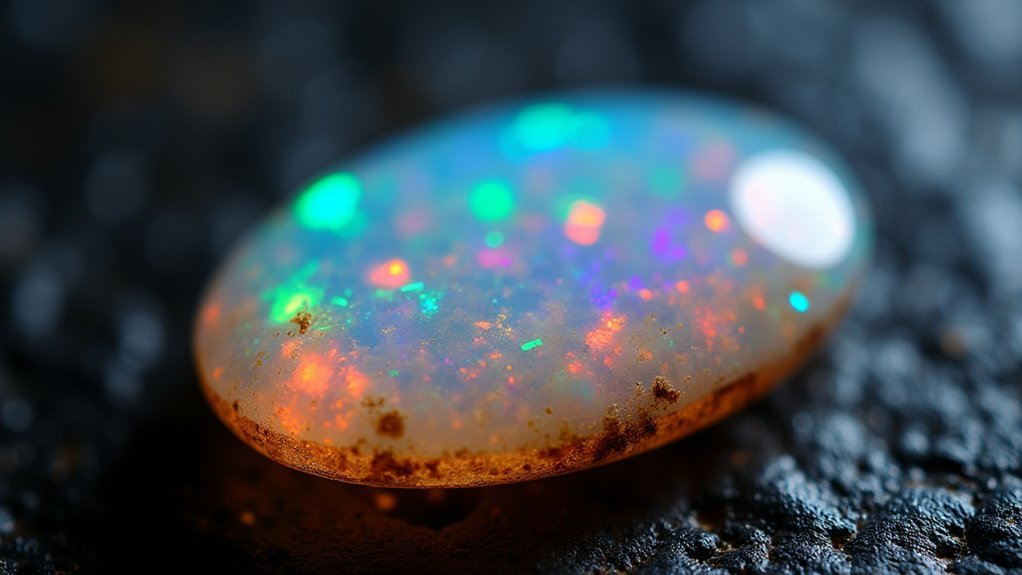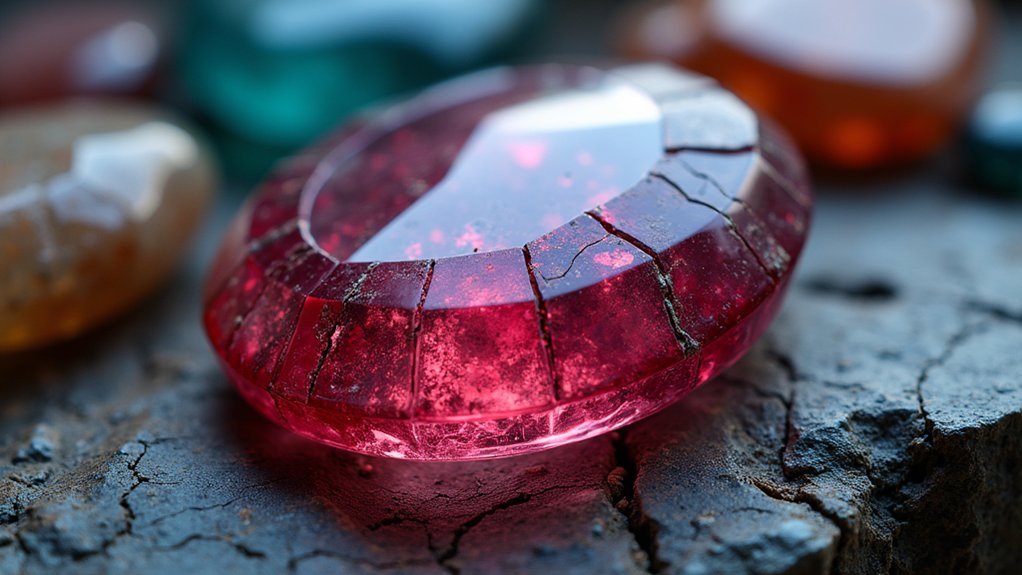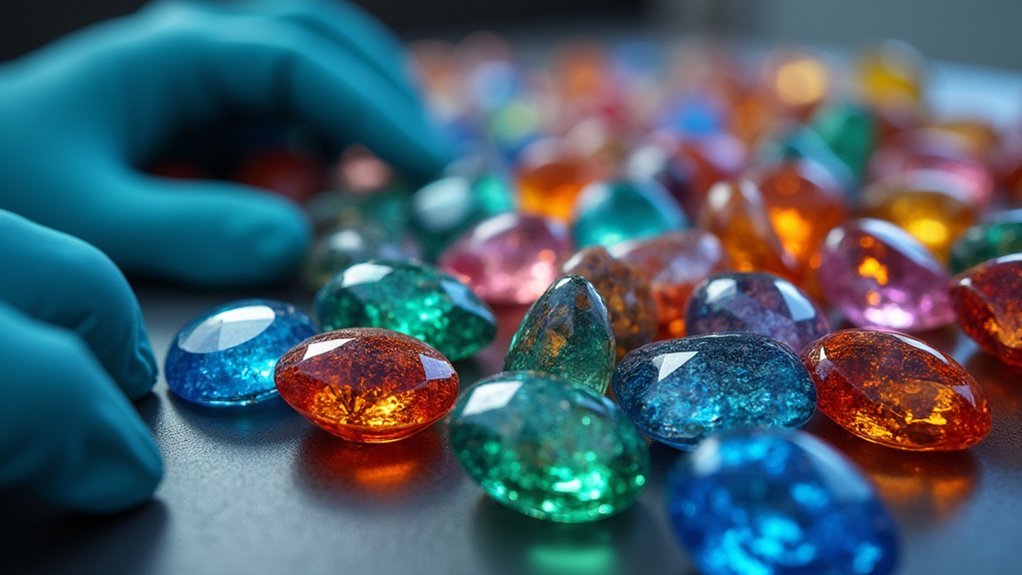You’re exposed to potentially dangerous sulfuric acid residues and toxic fumes when handling sugar acid treated gemstones, putting your health at serious risk through skin contact, inhalation, and long-term chemical exposure. These treatments can cause severe chemical burns, respiratory distress, and systemic toxicity including headaches and gastrointestinal issues. The acid’s corrosive nature creates microscopic contamination that’s difficult to detect without proper testing, while compromised stone integrity leads to ongoing leaching concerns that’ll help you understand the full scope of protective measures needed.
Chemical Composition of Sugar Acid Treatment Solutions

Gemstone enhancement through sugar acid treatment involves a deceptively simple yet chemically complex process that combines ordinary table sugar with one of industry’s most dangerous acids.
You’re dealing with a solution that typically contains sucrose dissolved in sulfuric acid, creating a mixture designed to penetrate porous gemstones like opals. The sulfuric acid serves as a catalyst, breaking down sugar molecules into carbon compounds that fill microscopic spaces within the stone to make beautiful, darker patterns.
However, you can’t ignore the inherent dangers of this combination. Sulfuric acid’s highly corrosive nature means you’re working with a substance that can cause severe chemical burns and release toxic fumes during carbonization.
The concentration levels determine both treatment effectiveness and your exposure risk, requiring meticulous safety protocols throughout the weeks or months needed for complete treatment.
Sulfuric Acid Exposure During Gemstone Processing
When you’re processing gemstones with sugar acid treatment, you’ll face two primary exposure risks from sulfuric acid that can seriously harm your health.
If you inhale the acid vapors, you’ll experience respiratory distress and potential long-term lung damage from the corrosive fumes.
Direct skin contact with the acid will cause severe chemical burns that require immediate medical attention, even from brief exposure.
Acid Vapor Inhalation Risks
During the heat-sugaring process for gemstone treatment, you’ll face significant respiratory hazards from sulfuric acid vapors that can cause immediate and long-term health damage.
When you inhale these toxic mists, they’ll irritate your throat, lungs, and nasal passages while causing chemical burns to your respiratory tract. You’ll experience coughing, shortness of breath, and potentially permanent lung damage from direct exposure.
Prolonged vapor inhalation leads to systemic toxicity, triggering headaches, dizziness, and gastrointestinal distress that can severely impact your health.
You must implement proper ventilation systems and wear appropriate personal protective equipment, including respirators, to protect yourself.
It’s essential that you receive thorough safety training to understand these serious health risks and master safe sulfuric acid handling techniques before engaging in gemstone processing work.
Skin Contact Chemical Burns
Direct skin contact with sulfuric acid during gemstone processing creates immediate and severe chemical burn hazards that can permanently damage your tissue.
Even diluted concentrations pose serious risks, causing symptoms ranging from painful redness to deep tissue destruction within minutes of exposure.
You’ll need thorough protection while handling acid-treated stones:
- Wear chemical-resistant gloves and safety goggles at all times
- Guarantee immediate access to emergency eyewash stations and safety showers
- Keep neutralizing agents readily available in your workspace
- Maintain proper ventilation to minimize accidental exposure risks
If acid contacts your skin, you must rinse immediately with copious water for at least fifteen minutes.
Don’t underestimate brief exposures – they can cause blistering and permanent scarring.
Proper training in handling procedures and first aid protocols isn’t optional.
Skin Contact Reactions From Treated Opals

When you handle sugar acid treated opals, you’re risking direct exposure to chemical residues that remain on the stone’s surface after processing.
Your skin can develop irritation, rashes, or even chemical burns from contact with leftover sulfuric acid compounds embedded in the gemstone.
If you’ve got sensitive skin or existing allergies, you’ll face heightened risks of adverse reactions that can range from mild irritation to severe allergic responses.
Chemical Residue Exposure
Although heat-sugared opals undergo treatment with sugar solutions and sulfuric acid to enhance their appearance, this process can leave dangerous chemical residues on the stone’s surface that’ll cause skin irritation when you handle them.
The severity of chemical exposure depends on several critical factors:
- Cleaning thoroughness – Inadequately cleaned stones retain more harmful residues
- Individual sensitivity – People with pre-existing skin conditions face higher risks
- Exposure duration – Prolonged contact increases chances of chemical burns or dermatitis
- Residual acid concentration – Sulfuric acid remnants vary between treated stones
You’ll want to ask jewelers about treatment and cleaning processes before purchasing opals.
If you have sensitive skin or acidic substance allergies, exercise extra caution when handling these gemstones to prevent potentially serious skin reactions.
Allergic Skin Responses
Because your skin comes into direct contact with treated opals through rings, necklaces, and earrings, you’re at risk for developing allergic reactions from residual sulfuric acid and other chemicals left behind during the heat-sugaring process.
If you have sensitive skin or chemical allergies, you’re particularly vulnerable to these reactions.
Contact with treated opals can cause redness, itching, and swelling on your skin. In severe cases, you might experience blistering that requires immediate jewelry removal.
You should always ask jewelers whether opals have been chemically treated before purchasing. Untreated stones pose considerably lower risks for skin irritation.
Reputable sellers must disclose treatment processes so you can make informed decisions about potential health risks from wearing treated gemstones against your skin.
Respiratory Hazards in Workshop Environments
While gemstone treatment processes can enhance the beauty of stones, the sugar acid method creates serious respiratory threats that demand your immediate attention.
The sulfuric acid used in heat-sugaring releases dangerous fumes that can cause respiratory tract irritation, persistent coughing, and potentially chemical pneumonitis if you’re exposed to significant quantities.
You must implement these critical safety measures in your workshop:
- Install effective fume extraction systems and maintain proper ventilation
- Use appropriate PPE, including respirators, when handling sulfuric acid
- Conduct regular safety training to reinforce awareness of respiratory risks
- Perform routine safety audits to guarantee proper handling protocols
Don’t underestimate these hazards—prolonged exposure to sulfuric acid vapors poses serious health consequences that require proactive prevention strategies.
Long-Term Stone Degradation and Stability Issues

Beyond the immediate health hazards in your workshop, the sugar acid treatment process creates lasting problems that affect the treated stones themselves.
You’ll find that heat-sugaring weakens structural integrity over time, particularly in porous opals. The carbonization process proves unstable, causing treated stones to experience color fading or undesirable hue changes when sugar residue reacts with moisture.
Prolonged acid exposure compromises your stones’ durability, making them more susceptible to scratches and chips.
Common white opals don’t respond favorably to heat-sugaring, often producing less desirable colors that diminish market value and stability.
Without disclosure regulations, you risk selling stones with compromised long-term stability to unsuspecting buyers, who’ll face unexpected deterioration.
Undisclosed Treatment Detection and Consumer Protection
When you purchase gemstones from dealers who don’t disclose sugar-acid treatments, you’re fundamentally buying blind into potential health and durability risks.
Purchasing gemstones without treatment disclosure means accepting unknown health risks and compromised stone integrity from potentially hazardous chemical processes.
Without proper testing or certification, detecting these treatments becomes nearly impossible for average consumers. The altered chemical composition can lead to harmful substance leaching, particularly concerning for those with skin sensitivities.
To protect yourself, focus on these essential strategies:
- Seek reputable dealers who provide thorough treatment disclosure and certifications
- Request laboratory reports from recognized gemological institutions before purchasing
- Ask direct questions about any treatments the stone may have undergone
- Consider untreated alternatives if you’re concerned about chemical exposure
Your increased demand for transparency helps drive industry accountability, ultimately protecting consumers from inadvertently purchasing potentially hazardous treated stones.
Safe Handling Protocols for Treated Gemstones

If you already own sugar-acid treated gemstones, implementing proper handling protocols becomes your first line of defense against potential chemical exposure.
Always wear gloves when handling these stones to prevent skin contact with residual chemicals that may cause irritation or allergic reactions.
Store your treated gemstones in cool, dry locations away from direct sunlight, which can degrade treatments over time.
Never expose them to high temperatures or harsh chemicals, as this compromises treatment integrity and potentially releases harmful substances.
Inspect your stones regularly for signs of wear or damage, since compromised gemstones pose increased health risks if they break or release particles.
Educate yourself about each stone’s specific treatment history, as varying chemical exposure levels require different precautionary measures.
Jewelry Worker Safety Guidelines and Equipment
While consumers need protective measures for their treated gemstones, jewelry workers face far greater exposure risks during the treatment process itself.
You must implement thorough safety protocols to protect against sulfuric acid and chemical fumes that can cause severe health complications.
Essential safety equipment you’ll need includes:
- Personal protective equipment – gloves, goggles, and respirators for direct chemical protection
- Proper ventilation systems – to prevent inhalation of dangerous fumes during treatment processes
- Emergency response stations – eyewash stations and first aid kits for accidental exposure incidents
- Safe disposal protocols – neutralizing sulfuric acid before disposal to prevent environmental contamination
You should receive regular training on chemical hazards and handling procedures.
Don’t underestimate these risks—proper safety measures can prevent serious injuries and long-term health consequences.
Acid Residue Testing and Neutralization Methods

You’ll need to test your sugar acid treated gemstones for harmful residue before handling or wearing them.
pH strips can quickly reveal if dangerous acid remains on the stone’s surface.
Once you’ve detected contamination, you can neutralize it using water rinses followed by a baking soda solution.
Detecting Acid Contamination
Because acid contamination from sugar-treated gemstones can create serious health hazards, you’ll need reliable methods to detect and neutralize any residual acids before handling or wearing these stones.
pH testing strips provide the most accessible detection method. You can identify acidic conditions on treated gemstone surfaces, revealing potential contamination that requires immediate attention.
Essential detection and neutralization techniques include:
- Testing gemstone surfaces with pH strips to identify acidic residues
- Rinsing contaminated stones with baking soda solution for effective neutralization
- Allowing adequate time for complete neutralization, especially with treated opals
- Implementing regular monitoring protocols to prevent long-term acid exposure
Regular testing protects both jewelers and consumers from harmful acid exposure.
You should establish consistent monitoring practices throughout your gemstone handling process to maintain safety standards.
Safe Neutralization Techniques
When handling sugar acid treated gemstones, proper neutralization techniques form your primary defense against chemical burns and respiratory hazards.
Begin by preparing a baking soda solution to effectively neutralize sulfuric acid residues on the gemstone’s surface. Carefully immerse the treated stone in this alkaline solution, allowing it to counteract any remaining acidity.
After neutralization, rinse the gemstone thoroughly with distilled water to remove all baking soda traces and prevent new residues from forming.
Throughout this process, you’ll need proper personal protective equipment including chemical-resistant gloves and safety goggles to minimize exposure to harmful substances.
Don’t rush the neutralization – give the baking soda solution adequate time to work before proceeding to the final distilled water rinse.
Alternative Treatment Options With Lower Risk Profiles
Several safer alternatives exist that can enhance opal appearance without exposing you to the health hazards of sugar-acid treatments.
These methods offer effective enhancement while prioritizing your safety and environmental responsibility:
- Epoxy resin stabilization – Provides protective coating for porous stones, improving durability without chemical health risks.
- Stable dyeing methods – Enhance color using non-toxic dyes that avoid aggressive chemicals like sulfuric acid.
- Natural oils and waxes – Improve appearance safely with minimal environmental impact and no harsh chemical exposure.
- Heat treatments – Less common for opals but can enhance color without chemicals, presenting lower risk profiles.
Many jewelers now advocate for these safer alternatives, recognizing that you shouldn’t compromise your health for gemstone enhancement.
These methods deliver comparable aesthetic results while protecting both craftspeople and consumers from dangerous chemical exposure.
Frequently Asked Questions
What Gemstones Should I Avoid?
You should avoid light white opals and Andamooka opals that undergo heat-sugaring treatments, plus improperly treated black onyx. These gemstones can develop color instability, structural damage, and potential health risks without proper disclosure.
Can Stomach Acid Dissolve Gemstones?
Your stomach acid can’t dissolve most gemstones like diamonds, sapphires, or opals. These hard minerals resist acidic dissolution and remain intact. However, softer organic gems like pearls might experience some damage from digestive acids.
Can Gemstones Cause Negative Effects?
You can experience skin irritation, allergic reactions, or respiratory issues from certain gemstones. Some contain toxic minerals like asbestos or lead, while chemically treated stones may release harmful substances over time.
What Crystals Are Not Safe to Wear?
You shouldn’t wear galena, realgar, malachite, or azurite due to toxic metals. Avoid chemically-treated opals and turquoise if you’re copper-sensitive. Don’t wear crystals with synthetic dyes or harsh chemical treatments.
In Summary
You’ll need to prioritize safety when working with sugar acid treated gemstones. Don’t handle them without proper protective equipment, and guarantee you’re working in well-ventilated areas. Test stones for acid residues before extended contact, and consider alternative treatments when possible. If you’re experiencing skin irritation or respiratory issues, stop handling treated stones immediately. Remember that long-term exposure risks aren’t worth compromising your health for gemstone enhancement.





Leave a Reply